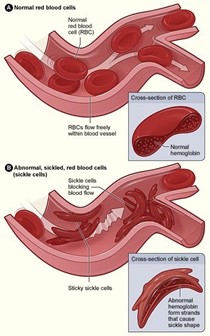A nurse is contributing to the plan of care for a school-age child who has sickle-cell disease and is experiencing a vaso-occlusive crisis. Which of the following should the nurse recommend to include in the plan of care?
Limit fluid intake during the evening
Perform passive range-of-motion exercises.
Apply cold compresses to painful areas.
Provide a low-protein diet
The Correct Answer is B
b. Perform passive range-of-motion exercises.
During a vaso-occlusive crisis in sickle-cell disease, blood flow to certain areas of the body may be restricted, leading to pain and tissue damage. Passive range-of-motion exercises can help promote blood circulation and prevent joint stiffness and further complications. These exercises involve gently moving the child's joints through their full range of motion without active participation from the child.
Explanation for the other options:
a. Limit fluid intake during the evening: Fluid intake is important in sickle-cell disease to prevent dehydration and maintain adequate blood flow. Restricting fluid intake during a vaso-occlusive crisis can further contribute to dehydration and may worsen the crisis. It is important to encourage fluid intake unless otherwise instructed by the healthcare provider.
c. Apply cold compresses to painful areas: Cold compresses are not recommended during a vaso-occlusive crisis in sickle-cell disease. Cold temperatures can cause vasoconstriction and further worsen the blood flow to affected areas, leading to increased pain and tissue damage. Warm compresses or warm packs may be used to promote vasodilation and provide pain relief.
d. Provide a low-protein diet: A low-protein diet is not specifically indicated in the plan of care for a vaso- occlusive crisis in sickle-cell disease. Adequate protein intake is important for overall nutritional needs and tissue repair. The focus of nutritional management in sickle-cell disease is usually on a well-balanced diet that includes adequate hydration and appropriate nutrient intake.
In summary, performing passive range-of-motion exercises is an appropriate intervention to include in the
plan of care for a school-age child experiencing a vaso-occlusive crisis in sickle-cell disease.

Nursing Test Bank
Naxlex Comprehensive Predictor Exams
Related Questions
Correct Answer is A
Explanation
The correct answer is a. Call EMS if a seizure lasts 5 minutes or more.
Explanation:
When providing home care instructions for a child with a seizure disorder, it is important to educate the parents about appropriate actions during a seizure. Calling emergency medical services (EMS) if a seizure lasts 5 minutes or more is crucial because it may indicate a condition called status epilepticus, which is a prolonged seizure or a series of seizures without full recovery of consciousness between them. Status epilepticus is a medical emergency that requires immediate medical intervention.
Option b, restraining the child at the onset of a seizure, is not recommended. Restraint can potentially cause harm to the child and increase the risk of injury. It is advised to create a safe environment by removing any nearby objects that could cause injury and placing a pillow or cushion under the child's head to prevent head injury.
Option c, offering the child a bubble bath every evening, is not specifically related to seizure management. Bathing routines can be continued as long as they are safe and supervised. However, it is important to ensure the child's safety during bathing, such as providing adequate supervision to prevent drowning or injury.
Option d, placing the child in a prone position during a seizure, is not recommended. Placing the child in a prone position (face down) during a seizure can obstruct the airway and increase the risk of respiratory complications. The child should be placed on their side, in a recovery position, to facilitate drainage of saliva or other fluids and prevent choking.
Overall, the most important instruction for the parents is to recognize the signs of prolonged seizure activity and to seek immediate medical assistance by calling EMS if a seizure lasts 5 minutes or more.
Correct Answer is C
Explanation
Answer: (C) The client is not grimacing
Rationale:
A) The client's blood pressure has been reduced:
While morphine can lower blood pressure due to its vasodilatory effects, a reduction in blood pressure is not necessarily a primary indicator of a therapeutic response to pain relief. It is more important to assess pain relief directly through the client's subjective experience and behavior rather than focusing on vital signs alone.
B) The client exhibits diaphoresis:
Diaphoresis, or sweating, can occur as a side effect of morphine administration but does not indicate that the medication is effectively relieving pain. In fact, diaphoresis might signal an adverse reaction or discomfort rather than a therapeutic effect.
C) The client is not grimacing:
The absence of grimacing suggests that the client's pain has decreased, which is a direct indicator of a therapeutic response to morphine. Observing a reduction in pain-related behaviors, such as grimacing, is a key assessment for determining the effectiveness of pain management in postoperative clients.
D) The client has an elevated heart rate:
An elevated heart rate may be a sign of unresolved pain or a side effect of morphine but is not a clear indicator of pain relief. Effective pain management with morphine typically results in a decrease in sympathetic nervous system responses, such as a high heart rate, rather than an increase.
Whether you are a student looking to ace your exams or a practicing nurse seeking to enhance your expertise , our nursing education contents will empower you with the confidence and competence to make a difference in the lives of patients and become a respected leader in the healthcare field.
Visit Naxlex, invest in your future and unlock endless possibilities with our unparalleled nursing education contents today
Report Wrong Answer on the Current Question
Do you disagree with the answer? If yes, what is your expected answer? Explain.
Kindly be descriptive with the issue you are facing.
